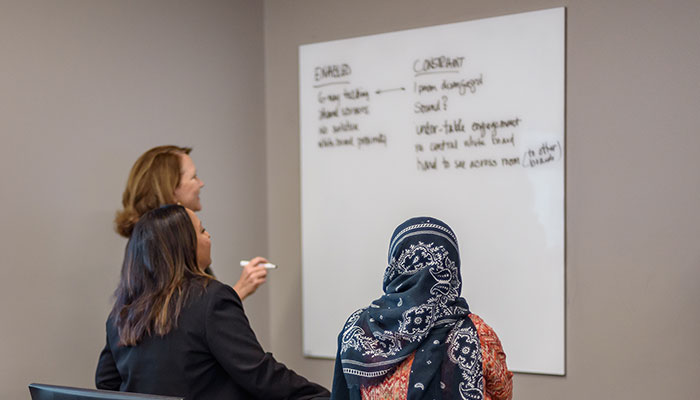This is not going to be that kind of class. Your safety buffer quickly disappears as the professor has you rearrange the furniture and form small groups. She expects you not only to talk but to talk with strangers about difficult topics. Now she's having you write on a whiteboard in close proximity to these people you barely know ... and she says that's what you'll be doing the whole term. She calls it active learning, and apparently this is a classroom designed for it.
Gina Sánchez Gibau sets these expectations early. To make everyone feel like they belong and they're welcome, she closes the usual distance between herself and her students and starts each day from a different spot in the room. The whole tone is one of respect – students feel comfortable talking in class because everyone is coming in with varying levels of knowledge. Conversation flows more naturally as the whole class, including the professor, circulates.
Once they have the hang of the active learning format, Gibau's students begin guiding discussions themselves. For active learning exercises like a scavenger hunt, they use Solstice to share pictures of things they care about or are intrigued by – Gibau has found concepts stay with them more if they bring in their own experiences and connect with one another. Besides, they're excited to see what other people choose and why, and that increases engagement.
Gibau's advice to any faculty trying to get their bearings in active learning spaces: Determine what is most effective in terms of facilitating active learning for your particular students in your particular discipline. For her, the white and glass boards, the movable furniture, and the ability to move around provide the freedom to use a large percentage of the class for active learning.
Viewing and trying things before the semester started – especially furniture configurations – with Mosaic staff also helped Gibau envision a range of new possibilities for different class sessions. She let go of the idea of the front of the room and instead focused on active learning approaches that could prepare her students for future collaborative work environments.
Gibau's entire teaching plan evolved as she became more comfortable with the active learning classroom and its features. For example, she developed a new approach in which the class forms three groups of eight for a chapter analysis of an ethnography. Two students act as discussion leads for each group then switch places among three groups, so they can have a series of discussions based on different questions. Gibau still facilitates to keep things on track, but her students lead.
Even introverted students who previously may have been quiet feel comfortable enough to participate in these group discussions. It is no longer a case of a few motivated people talking most; everyone feels more connected. This small, intimate atmosphere is key – when Gibau next teaches in a more traditional classroom, she plans to intentionally rearrange furniture to create it.


